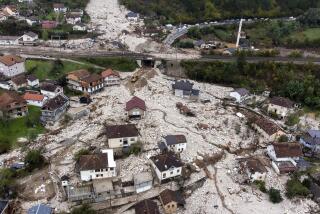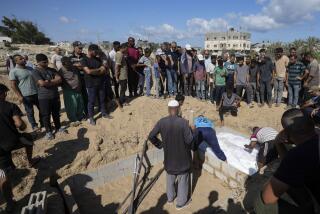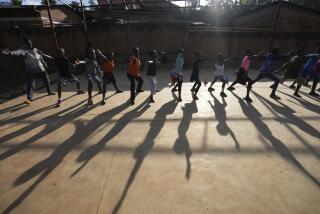Kosovo Sites May Contain Mass Graves
LJUBENIC, Yugoslavia — At what could be one of the bloodiest scenes of atrocities against ethnic Albanians, Italian peacekeepers spent Friday guarding a series of sites in western Kosovo that may hold as many as 350 bodies.
Residents say Serbian paramilitary forces gunned down hundreds of ethnic Albanians in massacres that began in this village April 1 and continued in the nearby mountains over an 11-day period.
Villagers who have ventured into the mountains say they have discovered the remains of at least 21 people.
If the massacres are confirmed by international war crimes investigators, this village and its surrounding area could contain the largest concentration of mass graves found in Kosovo--a province of Yugoslavia’s main republic, Serbia--since the North Atlantic Treaty Organization’s 11-week air war ended last month.
Peacekeepers with the NATO-led Kosovo Force, or KFOR, emphasized Friday that they remain cautious about local reports of 350 bodies, and they characterized the areas they are guarding as “possible sites of mass graves.”
Dutch Maj. Jan Joosten, a KFOR spokesman, added that the area will be swept for land mines before investigators begin examining the sites.
So far, less than half the 1,440 people who once inhabited this village have returned since the Italian peacekeepers rolled into town last month.
Villagers say the massacres began when Serbian forces surrounded the village, fired on residents and torched homes. Villagers believe that as many as 51 people were slain April 1, and many of the 85 homes burned in Ljubenic during the war are thought to have been set on fire that day.
Skeletal remains of at least four victims could be found scattered around the village Friday, much to the horror of residents such as Shaban Binak Huskaj. He returned home four days ago to find piles of clothing and shoes in his frontyard and human bones in his backyard.
Huskaj is further tormented by the fact that he fled Ljubenic on April 1 without his 18-year-old son, Feim.
“I don’t know how I haven’t just gone insane,” said Huskaj, as he stood a few yards away from a complete human skeleton. “I know my son stayed here, and now I’m seeing remains in my backyard.”
Huskaj pointed to a large, circular patch of scorched ground in another area of his yard where he believes bodies were burned.
Off a narrow road less than a quarter of a mile from Huskaj’s home are the clothed remains of two more skeletons. Villagers say they have been unable to identify the skeletons, which they fear are those of former residents.
Another resident, Sali Huskaj, said he fled into the mountains on the first day of the massacres after hearing the sound of gunshots ringing out in the village.
For six days he stayed in a mountainside home with his daughter and a neighbor, until gunshots rang out again the afternoon of April 7. Moments later, Huskaj said, he saw two columns of people, about a mile and a half long, heading back down the mountain toward a canyon.
Huskaj said that he joined the fleeing crowd and that about two dozen people were directly ahead of him.
“I didn’t think the Serbian paramilitaries would follow us,” the 58-year-old said. “But the snow was deep, and they came after our tracks. We heard someone speaking in Serbian, and I told my daughter and neighbor that we had to escape, but when we tried, they started shooting.”
Huskaj said his daughter and neighbor fell to the ground.
“Then I heard what sounded like a thousand shots being fired at the group ahead of me,” Huskaj said. “I slid into the river and floated away.”
Huskaj said he thought that his daughter and neighbor had been killed until he met them seven hours later back in the mountains, where he remained in hiding for the next 11 days.
He said he returned Sunday to the scene of the shooting, where he found the remains of 21 people.
“I believe the hills are filled with dead people,” said Huskaj, who added that he led NATO peacekeepers to the site. “The grass has grown a lot, so we can’t find them now, but I know they’re there.”
More to Read
Sign up for Essential California
The most important California stories and recommendations in your inbox every morning.
You may occasionally receive promotional content from the Los Angeles Times.










